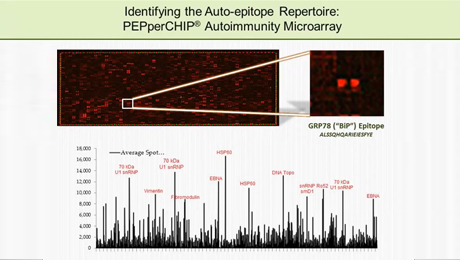Webinars and Videos
Browse our video library for tutorials and webinars on demand.
Presented by: John D. Mountz, MD, PhD, Professor of Medicine, University of Alabama at Birmingham, USA
Date: December 10, 2015
Autoreactive B cells are associated with the development of several autoimmune diseases, including systemic lupus erythematosus (SLE) and rheumatoid arthritis (RA). The low frequency of these cells represents a major barrier to their analysis. Antigen (Ag)-tetramers prepared from linear epitopes represent a promising strategy for the identification of small subsets of antigen-reactive immune cells. This is challenging given the requirement for identification and validation of linear epitopes and the complexity of autoantibody responses, including the broad spectrum of autoantibody specificities and the contribution of isotype to pathogenicity. We therefore tested a two-tiered peptide microarray approach, coupled with epitope mapping of known autoantigens, to identify and characterize autoepitopes using the BXD2 autoimmune mouse model. Microarray results were verified through comparison with established age-associated profiles of autoantigen specificities and autoantibody class switching in BXD2 and control (B6) mice and high-throughput ELISA and ELISPOT analyses of synthetic peptides. There was bona fide presence of ribonucleic acid binding proteins (RBP) cryptic autoAgs that were not predicted by Ag prediction programs. Tetramers were prepared from two linear peptides derived from two RBPs: lupus La and 70 kDa U1 small nuclear ribonucleoprotein (snRNP). Abnormal B cell phenotypes in tetramer reactive B cells were characterized. The present work validates the utilization of linear autoepitopes for analysis of the autoantibody repertoire and establishes a systematic, experimental approach to autoepitope identification and autoantigen tetramer-based B-cell isolation. This approach is readily adaptable to analysis of other autoimmune models and, potentially, analysis of patient-derived samples.
About the Presenter
Dr. Mountz received his PhD in elementary particle physics and his MD from Ohio State University. He then carried out an Internship and Residency in Internal Medicine at Wake Forest University and a Fellowship in Rheumatology at Wake Forest University, followed by a second Rheumatology fellowship at NIH. Dr. Mountz is currently a Board certified, practicing rheumatologist and Professor of Medicine and Microbiology at the University of Alabama at Birmingham. He is also the Goodwin-Blackburn Research Chair in Rheumatology, member of the American Society of Clinical Investigation (ASCI) and the Association of American Physicians (AAP) and actively reviews grants for the NIH, Alliance for Lupus Research (ALR) and Arthritis Foundation. He is an editor of 'Rheumatology: Current Research and Discovery Medicine'.
Dr. Mountz has made several seminal contributions to the role of oncogenes and Fas-mediated apoptosis in the rheumatic diseases. He was one of the first investigators to apply molecular biology techniques to understanding autoimmunity which led to the initial discovery that oncogenes (including Myc and RelB) were increased in autoimmune strains of mice (BXSB, Faslpr/lpr, NZB/W). Dr. Mountz was also the first investigator to genetically correct autoimmune disease by direct injection of a CD2-mouse Fas gene construct into single-cell embryos of MRL-Faslpr/lprmice. Most recently, utilizing flow cytometry, confocal imaging analyses, and genetically modified mice he made the first observation that type I interferon-promotes the development of lupus through follicular translocation of marginal zone B cells leading to loss of tolerogenic marginal zone macrophages in human and mouse models. He and colleagues also generated tetramers to enable enrichment and phenotyping of RNA binding protein reactive B cells in autoimmune mice. These discoveries in model systems have led to study of the regulation of pathogenic cells and strategies to inhibit their function using cells obtained from human RA and SLE patients.


